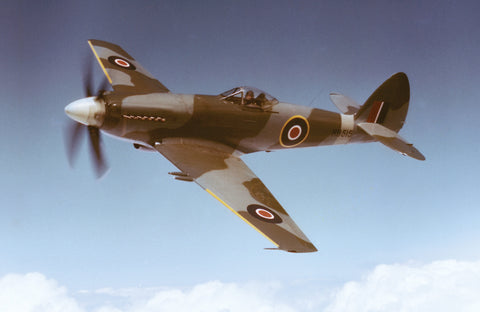
The Spiteful Was Better Than the Spitfire, But Even That Wasn’t Good Enough
The little-remembered Spiteful was the last iteration of the famous and long- lived line of Supermarine Spitfires. It was also noteworthy as the fastest British piston-engine fighter to enter production, although few were built before the project was cancelled. The Spiteful had taken too long to develop and did not reach production until World War II was over and jet-powered fighters were coming into use. Nevertheless, its protracted development did allow it to play a transitionary role in the Jet Age.
This aircraft,
with a longer fuselage than the Spitfire’s and with a redesigned wing, is
considered the first true Spiteful prototype. It first flew in January 1945.
In September 1942 Britain’s Air Ministry asked Supermarine to improve the Spitfire’s flying qualities at high speeds. The latest versions were approaching the speed of sound in power dives, and the effects of compressibility—the shock waves and instability created by the air flowing over the wing or tail at such high speeds—were becoming a problem. That phenomenon soon became known as the “sound barrier,” which would not be broken until the advent of high-performance rocket and jet-powered aircraft in the late 1940s.
In the case of the Spitfire, the engineers determined that the best solution to the compressibility issue was to reduce drag by replacing the famous elliptical wing with a smaller one of an entirely new design. The new wing would have a shorter span and a straight-tapered planform, with the wing area reduced from 242 to 210 square feet. In addition, it had a thinner, laminar- flow section. The thickest part of the laminar-flow section was farther back on the wing’s surface than it was on a conventional wing and that moved the point of boundary layer separation—where the smoothly flowing air lifts off the wing surface—farther back as well. The result was to reduce skin-friction drag and enhance control at higher speeds. The shorter span was also expected to increase the fighter’s rate of roll. Other departures from the traditional Spitfire design included the introduction of a wide-track, inward-retracting landing gear to improve ground handling and an increased armament of four 20mm cannons. The new version of the Spitfire was deemed sufficiently different to be given a whole new name, the Spiteful.
The Seafang
was an attempt to create a Spiteful for the Royal Navy. It sported a pair of
three-bladed, contra-rotating propellers.
The disadvantage of laminar-flow wings was that they required far more precise manufacturing tolerances than conventional wings. Even small imperfections of shape or finish could have a detrimental effect on performance. The Spiteful’s new wing took such a long time to design and build that the Air Ministry criticized the company for its slow progress. In addition, the Supermarine design and development staff was deeply involved with developing other improved versions of the Spitfire. As a result, the first Spiteful prototype, a Spitfire XIV fitted with the new laminar-flow Spiteful wings, did not make its first flight until June 30, 1944. The first true Spiteful prototype, which also included a new fuselage with a slightly raised cockpit to improve visibility over the long nose, did not fly until January 1945.
Like the Spitfire, the new fighter was supposed to come in two versions, one with the Rolls-Royce Merlin and the other with the Griffin engine. However, the Merlin version was cancelled by the time the wing was ready, leaving only the more powerful Griffin-engine Spiteful. The new fighter was 32 feet 11 inches long, had a wingspan of 35 feet and a gross weight of 9,950 pounds. Its 2,375-hp Griffin gave it a service ceiling of 42,000 feet and maximum speed of a blistering 483 mph. The Spiteful performed well and was generally pleasant to fly at high speeds, but the story was different at lower speeds, where the Spitfire proved noticeably superior. One problem was that the Spiteful would drop one wing without warning when it approached stall. Investigation revealed that when the Spiteful’s wing stalled, it began from the tip inward, whereas the Spitfire’s wing began to stall from the root outward, producing a gentler and more controllable stall. Supermarine introduced numerous design tweaks to resolve the Spiteful’s handling problems, including larger tail surfaces. The tweaks eventually made the Spiteful an acceptable fighter, but the modifications increased drag so much that the new aircraft did not markedly outperform existing production Spitfires. Furthermore, with the war rapidly coming to an end and jet fighters in the offing, the RAF regarded the Spiteful as redundant. As a result, on September 23, 1945, the Air Ministry cancelled its order. Supermarine delivered only 17 production Spitefuls and none ever reached operational squadrons.
The
wings of the Spitfire (left) and Spiteful show their obvious differences.
In parallel with the Spiteful, Supermarine developed a carrier-based naval version of the new fighter. Called the Seafang, it differed from the Spiteful principally in having folding wings, a “sting” type tail hook, two contra- rotating propellers to reduce torque during take-off and room for reconnaissance cameras inside the fuselage. The Seafang’s development was even slower than the Spiteful’s and it was first flown in January 1946. The Royal Navy soon abandoned it in favor of the Hawker Sea Fury and the de Havilland Sea Hornet. The navy did order 89 examples of the Supermarine Seafire FR 47, which was similar to the Seafang and eventually saw combat during the Korean War.
The Spiteful represented the absolute apex of piston-engine fighter development. Its story might have ended differently had it entered production a year earlier, but it arrived too late. The Spitfire became legend because it was the right airplane in the right place at the right time, but the Spiteful was lost to obscurity. Nevertheless, its heritage did live on. The laminar- flow wings developed for the Spiteful were subsequently fitted to Supermarine’s first production jet fighter, the Attacker, of which 185 were manufactured.
